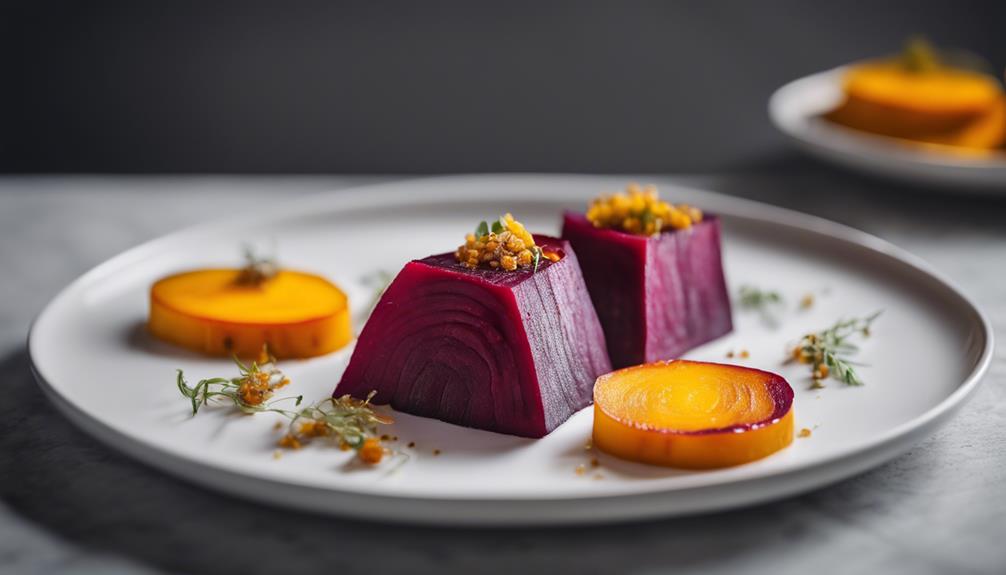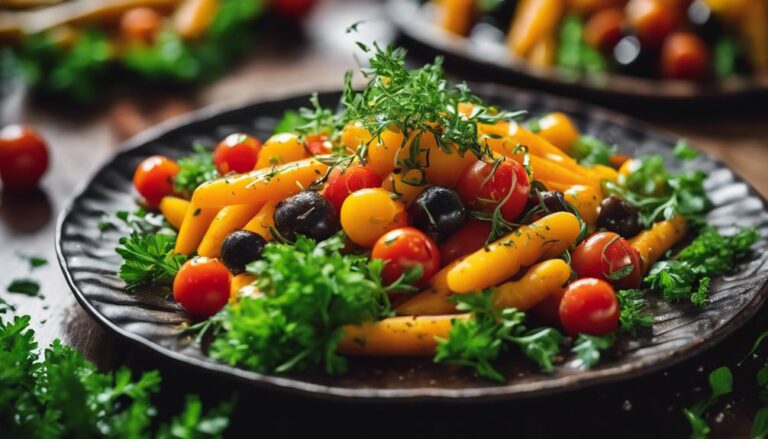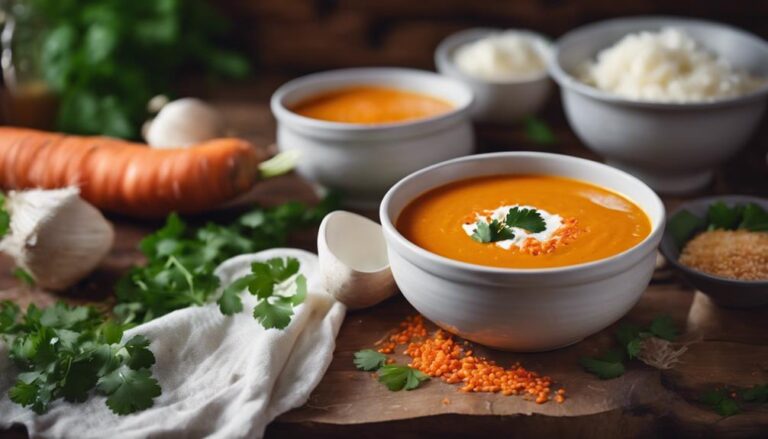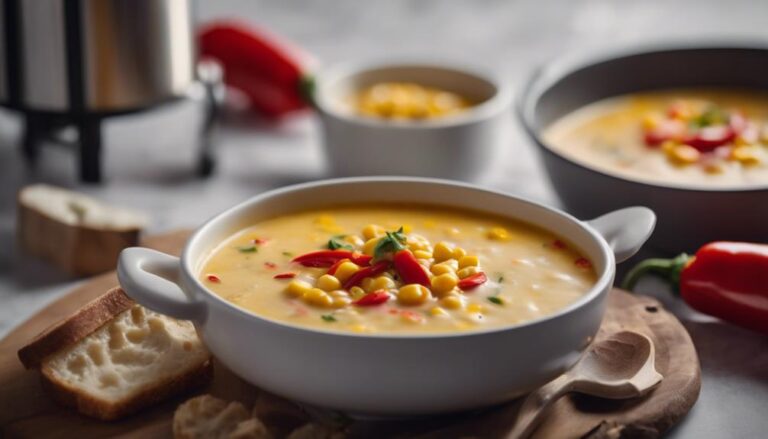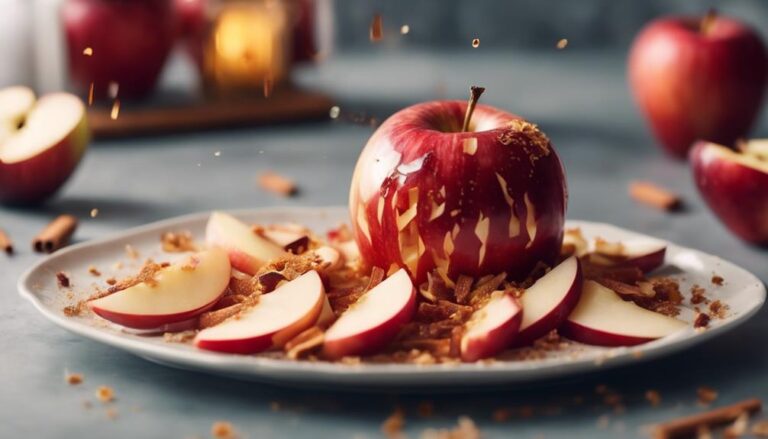Special Sous Vide Roasted Red Beet and Butternut Squash
Imagine the rich, velvety texture of roasted red beets and the creamy sweetness of butternut squash coming together in a dish that promises to elevate your culinary repertoire. Discover the secrets behind achieving that perfect balance of flavors and textures through the meticulous art of sous vide cooking. The precision and finesse involved in this cooking method will reveal a depth of taste you never knew was possible. But that's just the beginning of the journey towards creating a truly unforgettable dining experience.
What You Will Learn Here
- Sous vide technique ensures precise cooking temperatures for tender beets and squash.
- Vacuum sealing locks in flavors and nutrients during the cooking process.
- Roasting after sous vide enhances caramelization and flavor intensity.
- Experiment with seasonings like rosemary or balsamic vinegar for added depth.
- Enjoy a fusion of earthy beets and sweet squash in a harmonious culinary experience.
Root Vegetable's Culinary Evolution
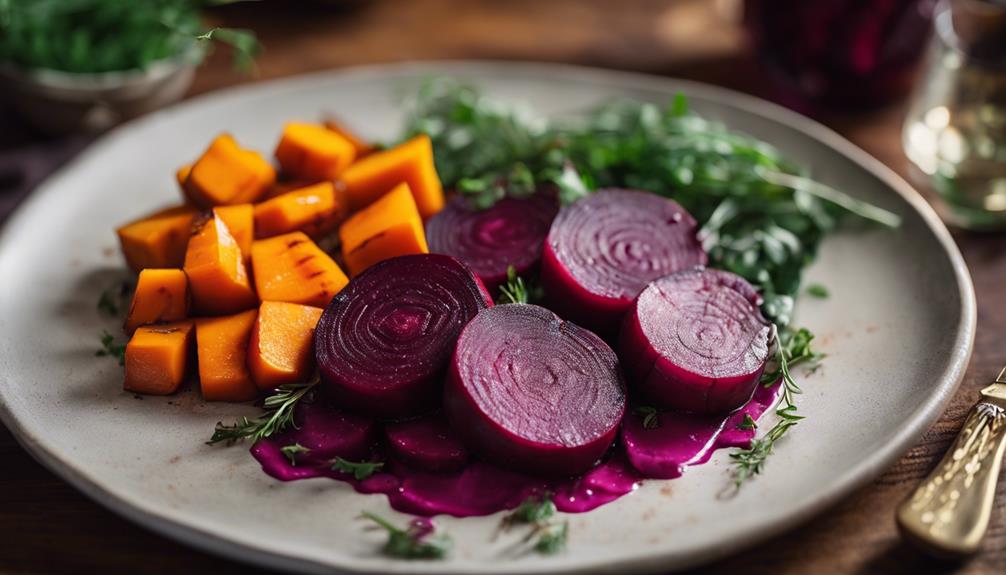
Root vegetables have a rich history in culinary traditions, evolving alongside cooking techniques over time.
Modern methods like sous vide have revolutionized how these vegetables are prepared, enhancing their natural flavors.
Pairing root veggies with trending ingredients creates exciting and delicious dishes that showcase their versatility in contemporary cuisine.
Root Veggies History
Throughout culinary history, these versatile underground vegetables have played a significant role in evolving various cuisines around the world. Root veggies, such as beets and butternut squash, have been cultivated since ancient times for their rich nutritional benefits. Packed with vitamins, minerals, and fiber, these veggies have been prized for their healthful properties.
Their seasonal availability has contributed to their global popularity. Root vegetables like carrots, turnips, and radishes are staples in many traditional dishes, adding depth and earthy flavors. Their ability to thrive in diverse climates has made them essential ingredients in cuisines from Asia to Europe, and the Americas.
Ancient civilizations recognized the value of root veggies, incorporating them into soups, stews, and roasted dishes. Their hearty nature and long shelf life made them ideal for sustaining populations through harsh winters.
Today, root vegetables continue to be celebrated for their versatility and ability to enhance the culinary landscape with their unique textures and flavors.
Modern Cooking Techniques
With advancements in culinary technology, cooking techniques for root vegetables have undergone a modern evolution, enhancing their flavors and textures in innovative ways. Temperature control plays a vital role in this transformation, allowing for precise cooking through methods like sous vide.
This cooking innovation involves sealing the vegetables in airtight bags and immersing them in a water bath set at a specific temperature for an extended period. Through this process, root vegetables are cooked evenly and retain their natural flavors and nutrients.
Food science has played a significant role in developing precision cooking techniques for root vegetables. By understanding the chemical reactions that occur during cooking, chefs can manipulate time and temperature to achieve excellent results. Precision cooking methods like sous vide ensure that root vegetables are cooked to the exact degree of doneness, resulting in a consistent texture throughout.
These modern techniques have revolutionized the way root vegetables are prepared, elevating their taste and presentation to new heights.
Flavor Pairings Trends
The culinary evolution of root vegetables has seen a rise in innovative flavor pairings trends that elevate traditional dishes to new heights. Flavor pairings, once limited to familiar combinations, have now expanded to include a fusion of diverse ingredients that bring out the best in each other.
Root vegetables like red beets and butternut squash are now being paired with unexpected companions, creating exciting culinary trends that push the boundaries of flavor exploration.
Seasonal ingredients play an important role in these flavor pairings, with chefs incorporating fresh produce to enhance the natural flavors of root vegetables. This emphasis on using ingredients at their peak ensures that dishes aren't only flavorful but also reflective of the changing seasons.
In the world of fusion cuisine, the blending of different culinary traditions has sparked a wave of creativity in flavor pairings. Chefs are experimenting with global ingredients to create harmonious combinations that surprise and delight the palate.
Root Vegetables' Pantry Staples
Root vegetables like red beets and butternut squash are essential staples in your pantry. These hearty veggies not only add vibrant colors to your dishes but also offer a range of nutritional benefits. Red beets are packed with antioxidants, fiber, and essential nutrients like folate and manganese. Butternut squash is rich in vitamin A, vitamin C, and potassium, making it a nutritious choice for your meals.
When it comes to cooking root vegetables, there are various methods you can use to enhance their flavors. Roasting root vegetables like red beets and butternut squash brings out their natural sweetness, while steaming preserves their nutrients. These veggies are versatile and can be incorporated into soups, salads, and side dishes, adding depth and earthiness to your meals.
Root vegetables are typically in season during the fall and winter months, making them perfect for hearty and comforting dishes. Stock up on these pantry staples to elevate your culinary creations throughout the year.
Trending Root Vegetable Dishes
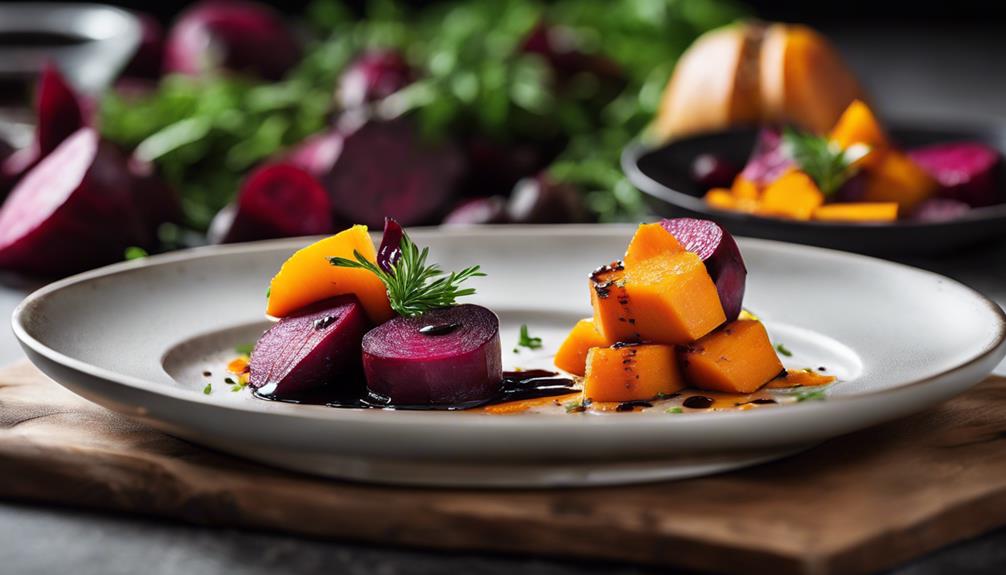
Discover the latest in root vegetable culinary trends with these three innovative dishes:
a delectable Sous Vide Beet Recipe,
a savory Butternut Squash Medley Recipe,
and an intriguing Beet and Squash Fusion.
These recipes showcase the versatility and unique flavors of root vegetables, perfect for elevating your cooking game.
Embrace the trend and impress your taste buds with these delicious and creative root vegetable creations.
Sous Vide Beet Recipe
Exploring the latest culinary trends, consider trying your hand at sous vide cooking to elevate the flavors of beets into a delightful dish. Sous vide offers several benefits for cooking beets, enhancing their natural flavors and textures.
Here's how to create a delicious sous vide beet recipe:
- Sous Vide Benefits, Flavor Enhancement: Sous vide cooking involves sealing the beets in airtight bags and cooking them in a water bath at a precise temperature. This method allows the beets to cook evenly, retaining their natural juices and flavors, resulting in tender and flavorful beets.
- Root Veggie Textures, Color Contrast: Beets, being a root vegetable, offer a unique texture when cooked sous vide. The gentle cooking process preserves the beet's firmness while enhancing its natural sweetness. Pairing the vibrant red of the beets with other root vegetables like carrots or turnips can create a visually appealing dish with a beautiful color contrast.
- Flavor Infusion and Seasoning: Experiment with adding herbs, spices, or a drizzle of balsamic glaze to infuse additional flavors into the beets during the sous vide cooking process, enhancing the overall taste profile of the dish.
Butternut Squash Medley Recipe
Consider elevating your culinary skills with a delectable Butternut Squash Medley Recipe, a trending dish featuring this versatile root vegetable. When preparing this dish, experiment with different squash varieties and cooking methods to enhance the flavors and textures.
Here are some tips to create a mouthwatering Butternut Squash Medley:
- Squash Varieties: Incorporate a mix of butternut squash, acorn squash, and delicata squash for a diverse flavor profile and visual appeal.
- Cooking Methods: Roast the squash with a drizzle of olive oil and a sprinkle of cinnamon for a sweet and savory combination. Alternatively, try sautéing the squash with garlic and herbs for a more aromatic dish.
- Beet Health Benefits: While focusing on the squash medley, remember that beets offer numerous health benefits, including improved digestion and lower blood pressure. Their earthy sweetness adds depth to the dish, complementing the squash flavors beautifully.
Experiment with these elements to create a Butternut Squash Medley that delights your taste buds and impresses your guests.
Beet and Squash Fusion
How can you combine the earthy flavors of beets with the sweet notes of butternut squash to create a trendy fusion dish that tantalizes your taste buds? Fusion cuisine allows for creative flavor combinations, and when it comes to culinary experimentation, unique vegetable pairings like beets and butternut squash can truly shine. Here's how you can master the art of beet and squash fusion:
- Roasting: Roasting beets and butternut squash together can intensify their flavors while creating a harmonious blend of tastes. The caramelization that occurs during roasting enhances the sweetness of the squash and complements the earthiness of the beets.
- Seasoning: Experiment with a variety of seasonings such as rosemary, thyme, or a touch of balsamic vinegar to elevate the flavors of the beets and squash. These additions can add depth and complexity to your fusion dish.
- Texture Play: Consider incorporating a crunchy element like toasted nuts or seeds to contrast the soft texture of the roasted vegetables. This contrast can provide a delightful sensory experience in each bite, making your beet and squash fusion dish truly memorable.
Expert Sous Vide Techniques
To master expert sous vide techniques, focus on temperature precision, time control, and vacuum sealing.
Ensuring that your ingredients are cooked at the exact temperature required will result in perfectly cooked dishes.
Controlling the cooking time and properly vacuum sealing the ingredients are key elements in achieving consistent and delicious results.
Temperature Precision
For ideal results in sous vide cooking, maintaining precise temperatures is crucial throughout the entire cooking process. Temperature control is a fundamental aspect of sous vide cooking, where ingredients are vacuum-sealed in bags and cooked in a water bath at a specific temperature for an extended period. This precision cooking method guarantees that your food is cooked evenly from edge to edge, resulting in perfectly tender and flavorful dishes.
When it comes to ingredient combinations, precise temperature control allows you to pair ingredients that require different cooking times. For example, when cooking red beets and butternut squash together, you can set the water bath to the ideal temperature that suits both ingredients. This way, the beets can cook to perfection without overcooking the delicate butternut squash.
Time Control
Achieving precise time control is essential for mastering expert sous vide techniques, ensuring your dishes are cooked to perfection.
One of the key benefits of sous vide cooking is the precision control it offers over the cooking time. With sous vide, you can set the exact temperature and cooking time to achieve consistent results every time.
When it comes to time management and meal prep, sous vide is a game-changer. You can prep your ingredients, vacuum-seal them in bags, and then cook them at the precise temperature for the specified time. This method allows you to plan your meals ahead of time, making it ideal for busy schedules or entertaining guests.
Vacuum Sealing
Using a vacuum sealer is crucial for expert sous vide techniques to guarantee airtight packaging of ingredients before cooking. The benefits of vacuum sealing include maintaining the integrity of flavors and nutrients, preventing moisture loss, and ensuring even cooking throughout the sous vide process.
When vacuum sealing your ingredients, make sure to remove as much air as possible to create a tight seal that enhances the cooking precision of sous vide.
For storage options, vacuum-sealed ingredients can be kept in the refrigerator or freezer for extended periods. This not only helps with meal prep but also reduces food waste by preserving ingredients for future use.
When choosing a vacuum sealer, opt for a reliable model with strong suction power to effectively remove air from the bags. Remember to follow the manufacturer's guidelines for your specific vacuum sealer to ensure proper usage and maintenance. Additionally, always use quality vacuum-sealing bags that are designed for sous vide cooking to prevent any issues during the cooking process.
Final Thoughts
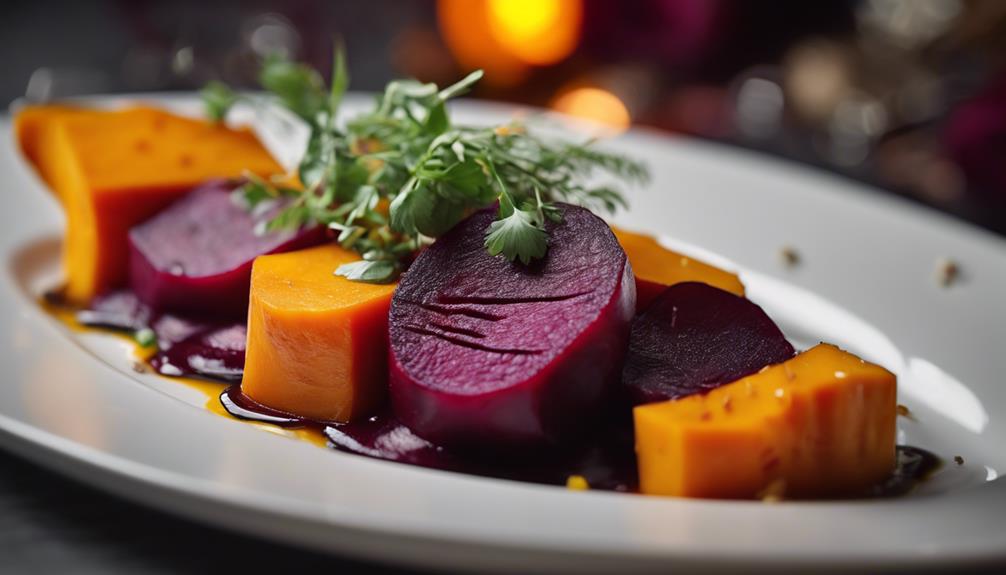
As you reflect on the delightful flavors of the Sous Vide Roasted Red Beet and Butternut Squash dish, consider the harmonious blend of earthy sweetness and tender textures that make it a truly memorable culinary experience.
This culinary exploration combines the vibrant hues of red beets with the comforting richness of butternut squash, creating a visually stunning and palate-pleasing dish.
Beyond its aesthetic appeal, this dish also offers numerous nutritional benefits. Red beets are packed with essential nutrients like folate, potassium, and fiber, while butternut squash provides a healthy dose of vitamin A, vitamin C, and antioxidants.
By preparing these ingredients using the sous vide method, you preserve their natural flavors and nutrients, resulting in a dish that not only tastes exquisite but also nourishes your body.
Whether you're a seasoned chef or a novice in the kitchen, this Sous Vide Roasted Red Beet and Butternut Squash dish is sure to impress with its depth of flavors and healthful qualities. Enjoy the culinary journey and savor every bite of this delectable creation.
Frequently Asked Questions
Can I Use Other Root Vegetables for This Recipe?
Yes, you can use different vegetables for this recipe. Experiment with carrots, parsnips, or sweet potatoes. Adjust cooking variations accordingly to suit each vegetable's texture and flavor. Enjoy trying out new combinations!
How Can I Adjust the Cooking Time for Larger Vegetables?
To adjust the cooking time for larger vegetables when using sous vide, consider lowering the temperature slightly and extending the cooking duration. This cooking technique guarantees even cooking throughout, regardless of the vegetable sizes you're working with.
Is It Necessary to Peel the Beets and Butternut Squash?
Leaving skins on beets and butternut squash offers benefits like enhanced flavor profiles and texture differences. It also helps retain nutrients during cooking. Not peeling can add depth to your dish while preserving goodness.
Can I Substitute the Herbs and Seasonings in the Recipe?
When substituting herbs and seasonings in a recipe, you have flexibility to personalize flavors. Experiment with different spices for unique twists. Ingredient swaps can lead to exciting flavor variations, enhancing your culinary creations.
What Are Some Creative Ways to Serve the Roasted Vegetables?
For presentation ideas, consider layering the vegetables with creamy goat cheese or serving them in individual ramekins. Flavor pairings could include a balsamic glaze drizzle or a sprinkle of toasted nuts. For leftover recipes, try adding them to salads or blending them into a vibrant soup. Ingredient swaps could involve using different root vegetables like carrots or parsnips.
Conclusion
To sum up, sous vide roasted red beet and butternut squash is a delicious and innovative dish that showcases the natural flavors of these root vegetables. By employing precise cooking techniques and seasonings, you can create a harmonious fusion of earthy sweetness and caramelized notes that will enhance your dining experience.
Experiment with different textures and flavors to personalize this dish, and savor the culinary journey of exploring the possibilities of sous vide cooking.
